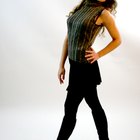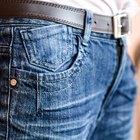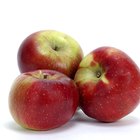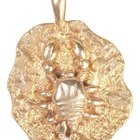
Cellulite is a fear of many women. While some accept it as a natural part of the aging process, others seek out any means of getting rid of it, including creams, natural remedies and strict dieting. Many associate cellulite with being overweight or obese. However, anyone can develop cellulite. It is important to understand the biological cause of cellulite to know your best option for minimizing the appearance of it.
Definition of Cellulite
Cellulite is a term that refers to the lumpy, dimply appearance of skin in areas with increased fat deposits underneath the skin. Cellulite is most often found on the stomach, thighs and butt of an individual. While 90 percent of adult women will develop it at some point, according to ManageCellulite.com, it is rarely found in men. It is not related to obesity because women of any shape may develop cellulite.
Cause of Cellulite
Cellulite develops because of the specific makeup of the skin, fat and connective tissue in the area. As an individual ages, the connective cords that connect the underlying muscle with the skin become less elastic. Between the muscle and skin is a layer of subcutaneous fat. When the fat layer accumulates more fat in the area and the cords are unable to stretch to make room for the fat, you develop the appearance of dimples. The dimply appearance is formed as the excess fat pushes up against the skin and the cords hold the skin back in certain areas.
Risk Factors
While weight gain does make cellulite more noticeable, cellulite is also found in individuals who are not overweight. According to MayoClinic.com, genetics plays a large role in whether an individual gets cellulite and its extent. Dealing with stress on a daily basis, having an inactive lifestyle and the use of hormonal contraceptives are also risk factors for developing cellulite.
Calf Cellulite
Cellulite is not frequently found on the calves, but it is possible. Butt, stomach and thigh cellulite is easy to cover up with clothes. However, if you live in a warm weather area and enjoy wearing dresses or shorts, this may be an area of cellulite you want to target. The best way to lose cellulite on your calves is to lose weight through diet and exercise. There is no way to target just the fat on your calves. Excess fat on calves will come off as your body begins losing fat overall. The fat will come off in specific places first, depending on how your body stores fat, which is based on your genetics.
Calf Exercises
Toning your calf muscles may help to diminish the appearance of cellulite. To tone the calf muscles, perform exercises that target the calf muscles a few times a week and focus on sets of 15 to 20 repetitions.
Begin with the simple standing calf raises. These may be performed on a step or on level ground. The calf raises on a step will allow for a larger range of motion. To do the calf raises on a step, place one foot on a small step and hang the heel of the foot off the step. Bring your opposite foot to hang behind your left heel. Hold onto a steady object to help your balance. Raise your heel up by pushing off with the forefoot on the step. Lower the heel to bring it slightly below the step. Repeat motion for desired repetition range. Switch feet and repeat for the opposite leg.
Related Articles

How to Rip Jeans at the Bottom

How Do You Tuck the Wings to Roast a ...

How to Dress a Petite Hourglass Shape

How to Get Rid of Cellulite & Spider ...

How to Roast an Eye Round Roast at High ...

How to Judge a Rodeo Queen Pageant ...

Teens & Cellulite

What Kind of Jeans to Wear to Hide the ...

Does Tea Cause Cellulite?

How Do Athletes Prevent Stretch Marks?

L-Carnitine for Cellulite

How to Change One's Communication Style ...

How to Cut Up Your Deer Tenderloins

How to Get Skirt Steak Tender

How to Dress a Big Stomach & Small Legs

How to Get Respect From a Male Scorpio

Bungee Jumping in New Jersey

Pros and Cons of Rocker Sole Sneakers

How to Grill Skinless Pheasant

Difference Between Hourglass Figure & ...
References
Writer Bio
Katie Vann has shared her passion for fitness and nutrition by writing professionally since 2006. She is a certified personal trainer and holistic health enthusiast. She holds a Bachelor of Arts in journalism from the University of Wisconsin.
Photo Credits
legs image by zaro4ka from Fotolia.com